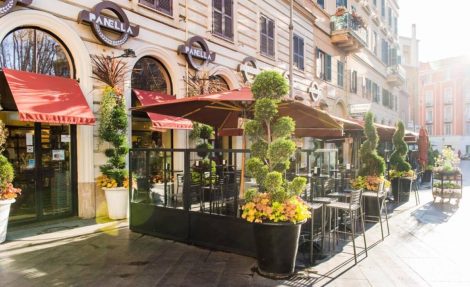Tijuana is a strange and intriguing city: at the crossroad of cultures and stories, its position as the border between the United States and Mexico has governed its past and still shapes its present. As a frontier place, its distinctiveness is less about a fixed, rigid identity that excludes the foreign and the unfamiliar, and more about integrating differences, establishing surprising dialogues, and not giving a damn about what anybody thinks.
Caesar's Salad
Caesar’s Salad, one of the most ubiquitous dishes in American restaurants and beyond, offers a unique entry point to better understand the cultural and culinary history of this somewhat ragged but energetic city that never ceases expanding. In fact, new waves of immigrants keep arriving, settling down how and where they can, expanding the urban fabric, and pushing the population towards 2 million. Definitely not the border post that started it all at the end of the nineteenth century.
The ingredients
In what is believed to be its original version (as described in a 1952 article), Caesar’s Salad includes romaine lettuce and garlic croutons tossed tableside with olive oil, egg, Worcestershire sauce, lemon juice, pear vinegar, mustard, Parmesan cheese, and white pepper. More recent versions include anchovies and garlic, and the dish is often prepared in the kitchen, rather than next to the patron’s table.
Cesare Cardini
This salad grants us a glimpse into the variety of the Italian migrant experience, also in unexpected places far from the large communities that established themselves in the United States, Canada, Brazil, Argentina, and Australia. In fact, the recipe was invented by Cesare Cardini, born in 1896 in Baveno on the Piedmont side of Lago Maggiore. He grew up in the restaurant business, getting his first experiences in his father’s establishment on the Isola dei Pescatori. As many Italians at the time, young Cardini emigrated to North America, settling in Montreal, Canada, when he was sixteen. He then moved to Sacramento, California, where he got exposed to the lively and quickly evolving restaurant culture of the United States. The new environment was long shot from the Italy he had left behind -- a new and still underdeveloped country. Cardini’s life changed in January 1920, when the Eighteenth Amendment of the United States Constitution went into effect, prohibiting the production, importation, transportation, and sale of alcoholic beverages (however, consumption was never illegal and neither was the production of cider and wine at home in small quantities). Restaurants saw one of the main sources of revenue disappear, while new and illegal speakeasy flourished, providing booze and entertainment for thirsty patrons.
Tijuana
Tijuana, right across the border from San Diego, suddenly became a major attraction for Americans and the Hollywood showbiz. Cardini realized there would be opportunities in this industry, and moved there in 1920. Easy to get to from the United States, located at the periphery of Mexico and far from the control of the central authorities, Tijuana saw the multiplication of restaurants and night clubs in the aftermath of the Eighteenth Amendment. A hippodrome for horse races and a plaza de toros for corridas were built, adding to the wild atmosphere of the city. The Casino Agua Caliente became one of the most fashionable places in North America, attracting Hollywood royalty and international jetsetters alike. Inevitably, seedier activities flourished, from gambling to prostitution.
Café Alhambra
As Tijuana local historian Fernando Escobedo De la Torre has reported, Cesare Cardini took advantage of the ebullient atmosphere to start a career in hospitality. He worked at the Cardinale, owned by Italian immigrants with the same surname. Cardini stayed when the restaurant went through massive renovations and became the swanky Café Alhambra, where - as his daughter Rosa narrated - he came up with the idea for the dish that still carries his name when one day they had almost run out of food and he had to find a way to feed his customers. Following the intuition that restaurants are also spectacles, he came up with the idea of tossing the salad in front of the guests, adding to the excitement of the event. Of course, due to the success of the salad, many others claimed to be the originators of the dish, including Cesare’s brother Alessandro, who called it “aviator’s salad,” and, more famously, Livio Santini, who stated he was inspired by a recipe his mother used to make during World War I in his native Trentino.
Caesar's Hotel
Cardini soon became the darling of foreign visitors and was able to get his clientele to follow him when he opened his own Caesar’s Place in 1926 and then later in 1930 when he inaugurated Caesar’s Hotel, which still exists in the same location under the management of the Plasencia family and the ownership of the Avakians, a family of Armenian immigrants from Turkey that acquired it right after World War II, in 1945. Unfortunately, the consequence of the 1929 crash of Wall Street Stock Exchange and the beginning of the Great Depression had a sudden and crushing impact on the restaurant business. Business became sparser and, eventually, Cardini left the restaurant to his partners and settled in San Diego. Apparently he also did not want to deal with another group of Italians that was making inroads in Tijuana, thriving on illegal alcohol: the Detroit mafia.
The sauce
Back in the United States, Cardini tried to manufacture and bottle his famed sauce, but the business never really took off. Today, Caesar’s Salad dressing is on sale in the most creative versions, some of which have little to do with the original recipe of Cardini, relatively simple and straightforward, as many traditional Italian recipes are. As a matter of fact, few Italians are familiar with the salad which, like other dishes of Italian origin such as the pasta Alfredo, are only known across the Atlantic. A global history of the countless contributions of Italian immigrants to cuisines around the world still needs to be written.
by Fabio Parasecoli















